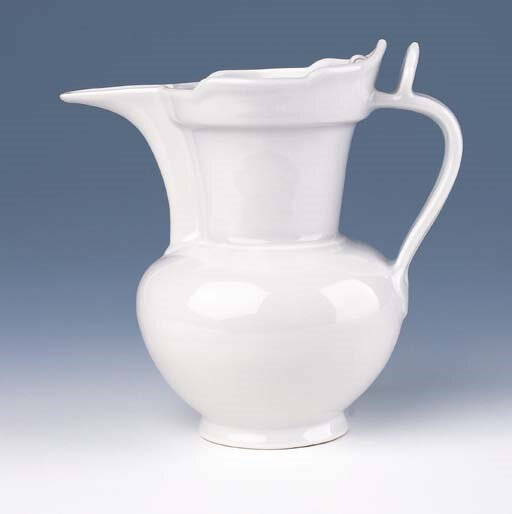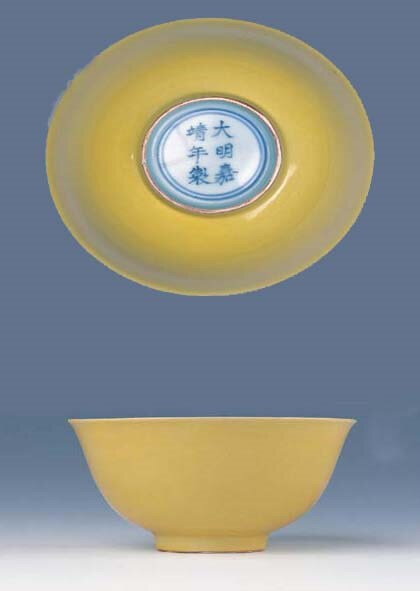Christie's. MING - THE AGE OF REFINEMENT. London, 16 November 1998
Ming dynasty Monochrome Porcelains sold at Christie's London, 16 November 1998
Lot 89. A rare anhua-decorated monk's cap ewer, sengmao hu, Yongle period (1403-1425); 8 in. (21 cm.) high. Estimate GBP 12,000 - GBP 15,000. Price realised GBP 18,400. © Christie’s Images Limited 1998
Of characteristic form, with a strap handle set to the shoulder, barbed 'monk's-cap' outline along the rim, and anhua-decorated ruyi terminals where the tall looping handle meets the body, a small eyelet on the rim interior, overall covered in a soft creamy-white glaze, eyelet restored, fitted box.
Note: Monk's cap ewers were used in ritual ceremonies of the Lamaist sect of Buddhism, and were mostly made in metal. According to historical texts, Halima, a highly influential lama of the Karma-pa sect of Tibet, attended in Nanjing in 1407 at the specific invitation of the Emperor Yongle the religious services to honour his deceased parents; on his arrival, the Emperor presented Halima with lavish gifts. It is highly likely that white-glazed monk's cap ewers with Tibetan inscriptions were made in Jingdezhen by order of the Emperor for this purpose. For a discussion on Yongle ewers of this form and their excavation from an early Yongle stratum (Stratum Five) in Zushan Road, Jingdezhen, see Liu Xinyuan, Imperial Porcelain of the Yongle and Xuande Periods Excavated from the Site of Ming Imperial Factory at Jingdezhen, 1989, colour pl. 8, pp.98 and 99, where an example without Tibetan characters is illustrated, and p.59, fig.4 for a drawing of a ewer incised with a Tibetan inscription from the same site.
White-glazed monk's cap ewers do on rare occasions bear incised Yongle marks: one with cover is in the Tsui Museum of Art, another in the Idemitsu Museum, a third was sold in these Rooms, 1 December 1997, lot 90, and a further example, without cover, is in the Carl Kempe Collection.
Unmarked examples, with and without anhua decoration, are in the British Museum, illustrated in Oriental Ceramics, 1982, vol.5, no.151; in the Metropolitan Museum of Art, New York, originally in the Herzmann Collection, illustrated by S. Valenstein, The Herzmann Collection of Chinese Ceramics, no.58, p.64; in the Museum of Far Eastern Antiquities, Stockholm, illustrated by N. Palmgren, Selected Chinese Antiquities from the Collection of Gustav Adolf, Crown Prince of Sweden, pl.96; in the Shanghai Museum, illustrated in Shanghai Hakubutsukan, pl.116.
A ewer similar to the present lot, with cover, from the Collection of Mr. & Mrs. P. Culloh, was sold in these Rooms, 10 December 1979, lot 322; two others, without covers, were sold in Hong Kong, 20 November 1984, lot 345, and 20 November 1985, lot 45; another, with anhua decoration, was sold in Hong Kong 14 November 1983, lot 111; an ewer with a Tibetan inscription was sold in New York, 19 November 1982, lot 252, and another, from the the Eumorfopoulos Collection, was sold in London, 30 May 1940, lot 314.
Lot 90. A small milk-white-glazed saucer-dish, Xuande six-character mark and of the period (1426-1435); 5 in. (12.9 cm.) diam. Estimate GBP 6,000 - GBP 8,000. Price realised GBP 6,900. © Christie’s Images Limited 1998
Evenly potted with curved sides and a slightly flaring rim, covered in a colourless glaze, painted inside the foot ring with the six-character mark within a double ring in underglaze blue, fitted box.
Provenance: Collection of Mr. and Mrs. Alfred Clark, no.829.
Note: Compare the slightly smaller similar dish included in the National Palace Museum, Taiwan, Special Exhibition of Hsan-te Wares, 1980, Catalogue no.120.
Lot 93. A turquoise-glazed anhua-decorated dish, Xuande six-character mark and of the period (1426-1435); 8 in. (22.3 cm.) diam. Estimate GBP 5,000 - GBP 7,000. Price realised GBP 8,280. © Christie’s Images Limited 1998
The plain white interior incised at the recessed centre with three cloud wisps, the exterior incised with two sinuous dragons chasing the flaming pearl amidst cloud swirls, under a mottled blue glaze ranging from turquoise to deep purple in tone, restored.
Lot 94. A yellow-glazed deep bowl, Encircled Jiajing six-character mark and of the period (1522-1566); 6 in. (16 cm.) diam.. Estimate GBP 5,000 - GBP 7,000. Price realised GBP 8,050. © Christie’s Images Limited 1998
The evenly rounded sides with a slightly everted rim covered at the interior and the exterior with a warm pale yellow glaze, small foot rim chip, fitted box.
Provenance: The T. Y. Chao Private and Family Trust, Part I, sold in Hong Kong, 18 November 1986, lot 248.
Exhibited: Hong Kong Museum of Art, Ming and Ch'ing Porcelain from the Collection of the T. Y. Chao Family Foundation, 1978, no.44.
Note: Compare the Jiajing yellow-glazed bowl of this size and form in the Metropolitan Museum of Art, New York, illustrated in Oriental Ceramics, 1982, vol.11, no.87; and the example from the Frederick Knight Collection, sold in Hong Kong, 18 May 1982, lot 33.

/https%3A%2F%2Fprofilepics.canalblog.com%2Fprofilepics%2F1%2F0%2F100183.jpg)
/https%3A%2F%2Fstorage.canalblog.com%2F03%2F02%2F119589%2F96711876_o.jpg)
/https%3A%2F%2Fstorage.canalblog.com%2F11%2F31%2F119589%2F94773502_o.jpg)
/https%3A%2F%2Fstorage.canalblog.com%2F20%2F83%2F119589%2F94772815_o.jpg)
/https%3A%2F%2Fstorage.canalblog.com%2F26%2F72%2F119589%2F75604929_o.jpg)
/https%3A%2F%2Fstorage.canalblog.com%2F59%2F60%2F119589%2F26458628_o.jpg)






/http%3A%2F%2Fstorage.canalblog.com%2F81%2F38%2F119589%2F129381784_o.jpg)
/http%3A%2F%2Fstorage.canalblog.com%2F00%2F49%2F119589%2F129072440_o.jpg)
/http%3A%2F%2Fstorage.canalblog.com%2F00%2F68%2F119589%2F127877768_o.jpg)
/http%3A%2F%2Fstorage.canalblog.com%2F82%2F49%2F119589%2F127238728_o.jpg)